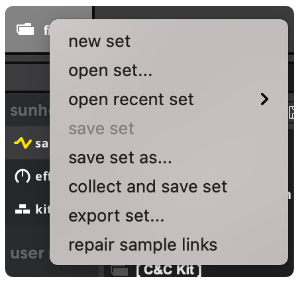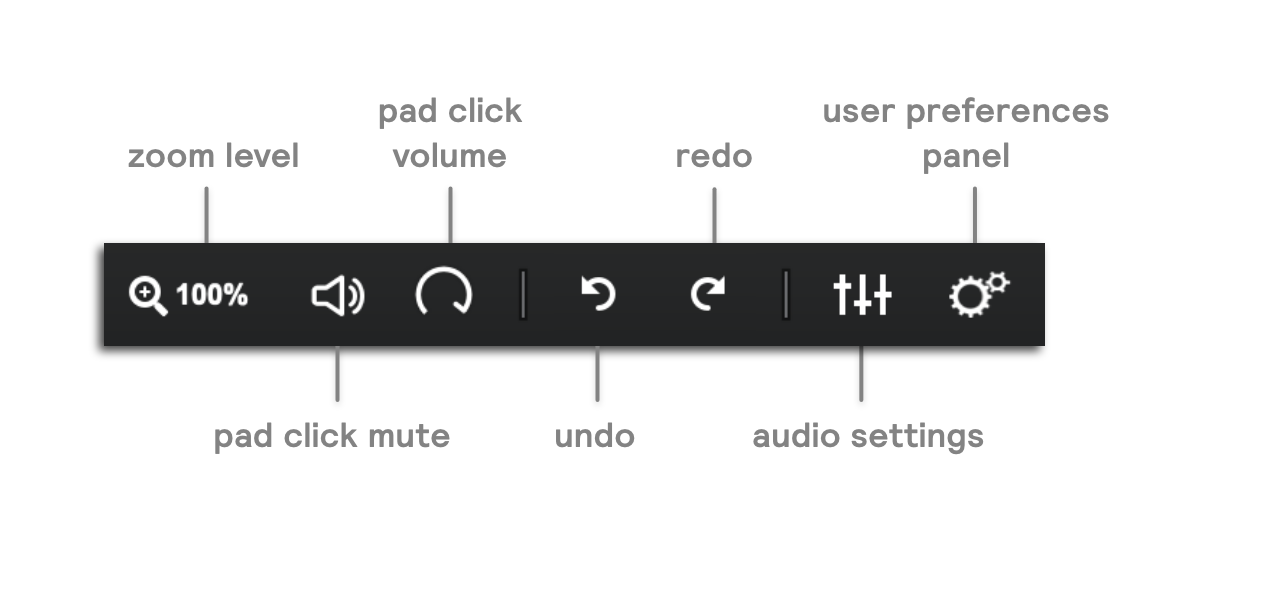File Menu and Application Settings

File Menu

The File Menu is located in the top left corner of the main window. This allows you to manage your sets. A set is essentially your session - it contains a chain of up to ninety-nine kits, which you can access in the Kit Selector panel and can be arranged, copied and deleted. The File Menu lets you create new sets, save and load them, as well as export sets that contain user samples so that they can be loaded onto another computer that has Sensory Percussion installed. You can double click on a set from anywhere on your computer to load it.
The file menu has the following options for managing your sets:
New Set
If you want to create a brand new set of twenty blank kits, then select New Set from the file menu. From here you can drag samples, drums, or full kits from your library into your set.
Open Set
Open Set opens a previously saved set on your computer. You can also open a set by double-clicking its .sps file in the Finder or File Explorer.
Open Recent Set
Hover over Open Recent Set to see the sets that you have been working on lately. Click on one of them to continue working on it.
Save Set
If you’ve worked on a set and haven’t saved it yet, then a little asterisk will appear next to the set name in the file manager reminding you to save your work. You can save your set by clicking on the file manager and selecting Save Set, or by pressing the keys ⌘ + S.
Sensory Percussion also auto-saves your work every 5 minutes. Just in case!
Save Set As...
Save Set As saves your work in a new file with a new name. After choosing your new Set name, the new set is opened into Sensory Percussion. You can also press the keys ⌘ + Shift + S to Save As....
Collect and Save Set
Collect and Save Set copies all user-samples into a folder with your .sps file. Unlike Export Set it does not create a new .sps file. This is helpful if you have used a bunch of samples from many locations on your computer, but you now want to store them all in one place.
Export Set
Export Set creates a copy of your current set and includes copies of any user-samples into a single folder. Very convenient for moving your work to a different computer.
Repair Sample Links
Repair Sample Links will fix any broken sample links in your set with samples from the selected folder. Keep in mind: selecting a sample folder with many, many samples will take a long time to process. You can also search for samples per kit (helpful if there is just one or two kits in your set that are missing samples) by right clicking on the kit slot.
Application Settings

The Application Settings icons are on the top right of the main window. These icons control global settings thorughout the software. It contains the following options:
Zoom Level
This allows you to adjust the window anywhere from 50% to 200%. You can also use the keyboard shortcuts ⌘-+ to zoom in and ⌘-- to zoom out in increments of 10%.
Pad Click Mute
This button toggles on and off the pad click sound. This means that when you click a pad with this unmuted, you will hear the samples that are assigned to that pad. If you click a pad with this muted, you won't hear the samples, but you will still hear them if you hit the pad with your sticks. It's good practice to turn on the pad click mute for live performances, in case you need to lcick around inside the pads, but don't want the audience to hear the samples being triggered.
Pad Click Volume
This knob is similar to the pad click mute button, but instead of turning the pad click sounds all the way on or off, it allows you to adjust their volume from 0% to 100%. This knob does not affect pad volume when you hit them with sticks, or the playback volume of anything else in your set.
Undo
This button undoes the last change you made to your set. You can also use ⌘-z.
Redo
If you just undid an action and want to get it back, you can click this button to do so. You can also use ⌘-Shift-z.
Audio In/Out Settings
This button opens up the Audio In/Out Settings Panel, where you can choose change your input/outputs, adjust sample rate, buffer size, and more. You can find a more detailed breakdown of this panel here.
User Preferences Panel
This button opens up the User Preferences Panel, where you can adjust the library sample audition volume, data collection settings, and more. You can find a more detailed breakdown of this panel here.